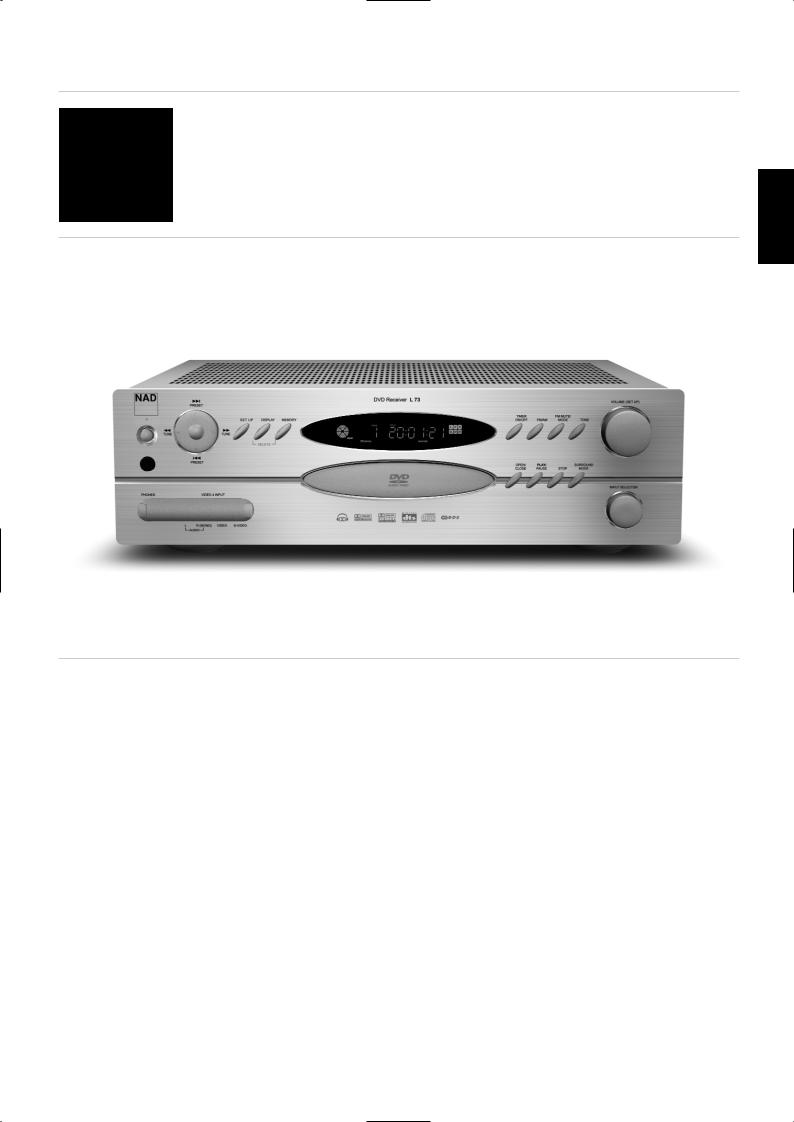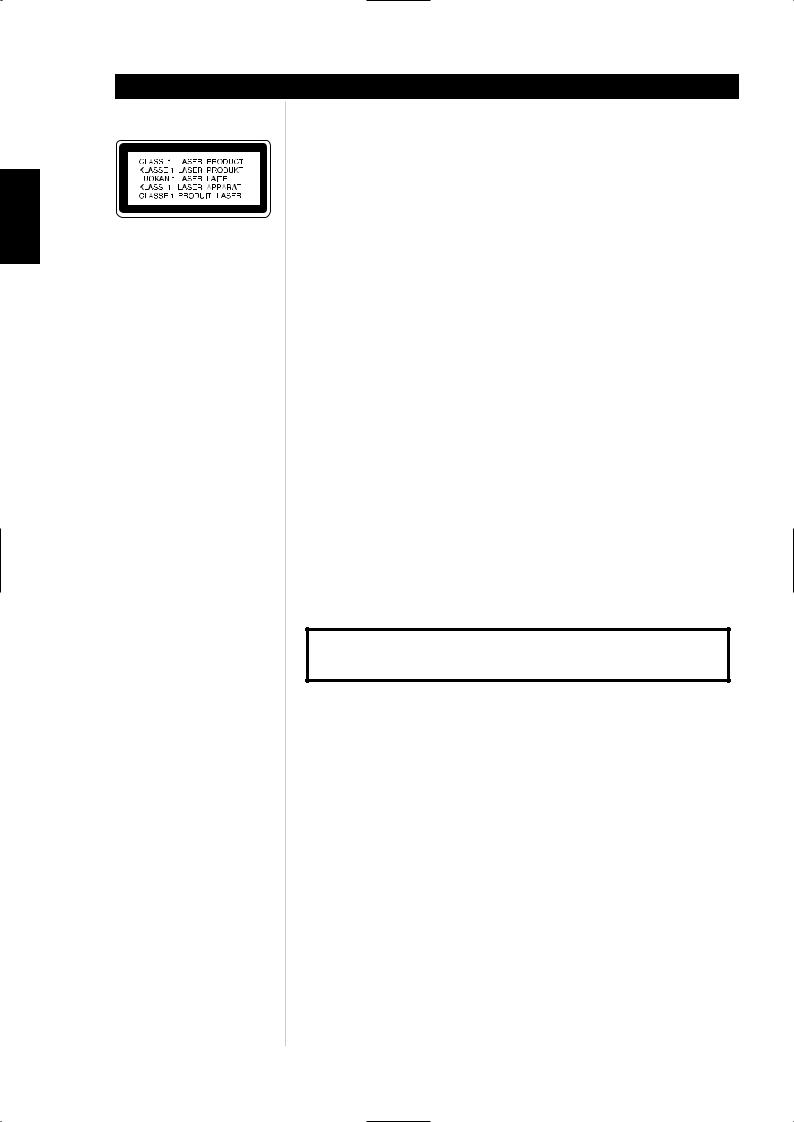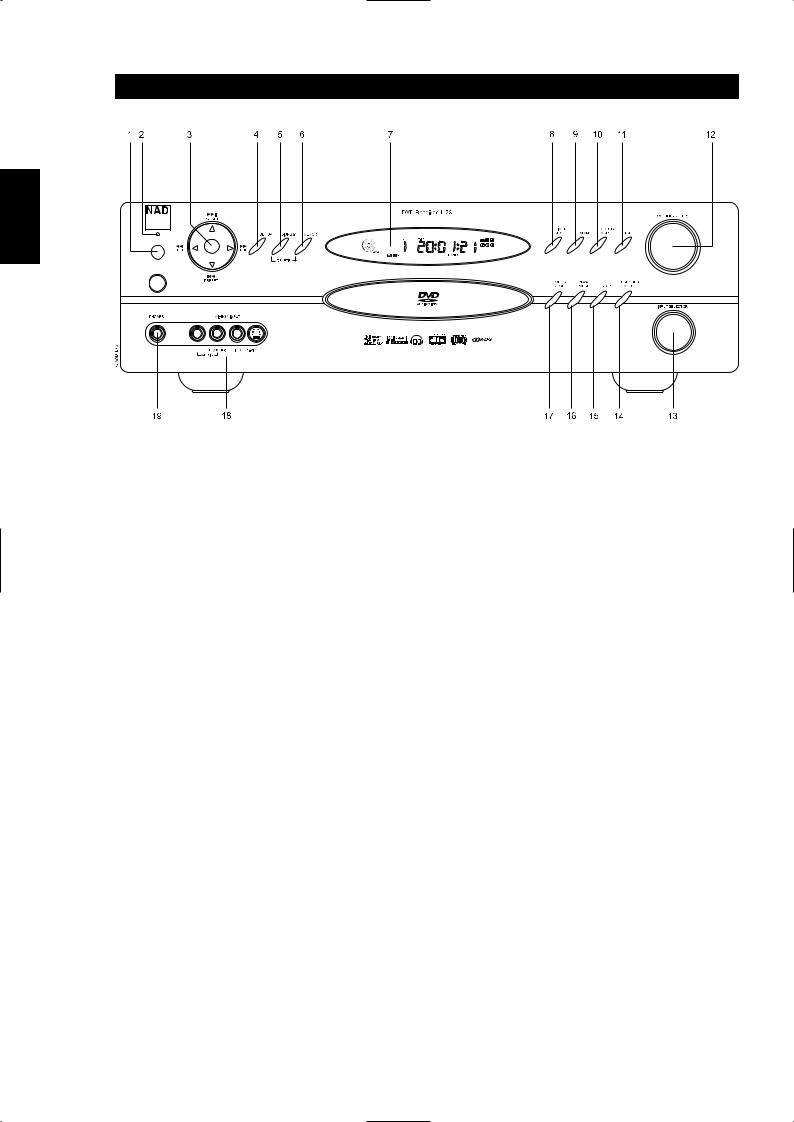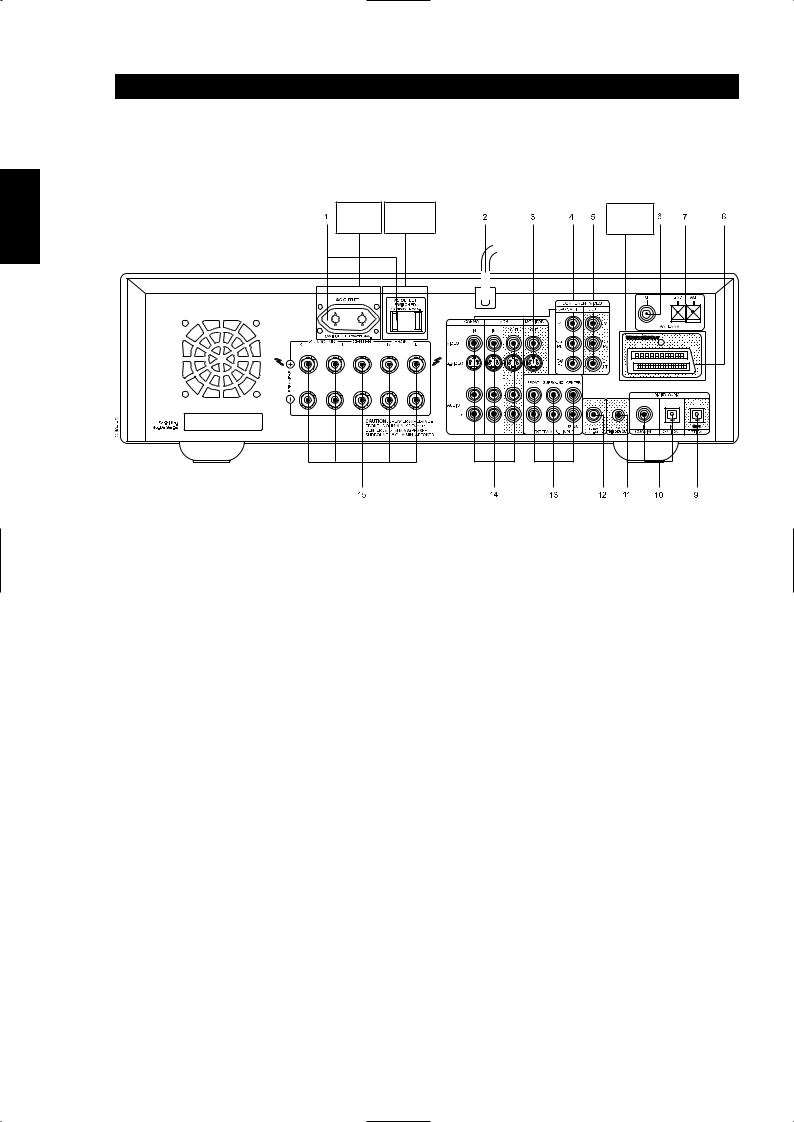NAD L 73 User Manual



 ® L 73
® L 73
DVD Receiver
Owner’s Manual
SVENSKA PORTUGUÊS ITALIANO ESPAÑOL NEDERLANDS DEUTSCH FRANÇAIS ENGLISH

SVENSKA PORTUGUÊS ITALIANO ESPAÑOL NEDERLANDS DEUTSCH FRANÇAIS ENGLISH
Introduction
SAFETY PRECAUTIONS
WARNING
TO REDUCE THE RISK OF FIRE OR ELECTRIC SHOCK, DO NOT EXPOSE THIS PRODUCT TO RAIN OR
MOISTURE.
CAUTION
TO PREVENT ELECTRIC SHOCK, MATCH WIDE BLADE OF PLUG TO WIDE SLOT, FULLY INSERT.
CAUTION
This Digital Video Disc Player employs a Laser System. To ensure proper use of this product, please read this owner’s manual carefully and retain for future reference. Should the unit require maintenance, contact an authorized service location. (See service procedure). Use of controls, adjustments or the performance of procedures other than those specified may result in exposure to laser radiation. To prevent direct exposure to laser beam, do not try to open the enclosure. Visible laser radiation when the enclosure is opened.
DO NOT STARE INTO BEAM.
FCC NOTICE
This equipment has been tested and found to comply with the limits for a Class B digital device, pursuant to part 15 of the FCC Rules. These limits are designed to provide reasonable protection against harmful interference in a residential installation.
This equipment generates, uses and can radiate radio frequency energy and if not installed and used in accordance with the instructions, may cause harmful interference to radio communications.
However, there is no guarantee that interference will not occur in a particular installation. If this equipment does cause harmful interference to radio or television reception, which can be determined by turning the equipment off and on, the user is encouraged to try to correct the interference by one or more of the following measures:
•Reorient or relocate the receiving antenna.
•Increase the separation between the equipment and receiver.
•Connect the equipment into an outlet on a circuit different from that to which the receiver is connected.
•Consult the dealer or an experienced radio/TV technician for help.
EXAMPLE OF ANTENNA GROUNDING AS PER NATIONAL ELECTRICAL CODE INSTRUCTIONS
CONTAINED IN ARTICLE 810 - RADIO AND TELEVISION EQUIPMENT.
NOTE TO CATV SYSTEM INSTALLER: This reminder is provided to call the CATV system installer’s attention to Article 820-40 of the National Electrical Code that provides guidelines for proper grounding and, in particular, specifies that the ground cable ground shall be connected to the grounding system of the building, as close to the point of cable entry as practical.
FCC WARNING
Changes or modifications not expressly approved by the party responsible for compliance could void the user’s authority to operate the equipment.
INDUSTRY CANADA REQUIREMENT
This Class B digital apparatus meets all requirements of the Canadian Interference-Causing Equipment
Regulations.
2

Introduction
SAFETY INFORMATION
WARNING
TO PREVENT FIRE OR SHOCK HAZARD, DO NOT EXPOSE THIS APPLIANCE TO RAIN OR
MOISTURE.
THE LIGHTNING FLASH WITH ARROWHEAD SYMBOL, WITHIN AN EQUILATERAL
TRIANGLE, IS INTENDED TO ALERT THE USER TO THE PRESENCE OF
UNINSULATED "DANGEROUS VOLTAGE" WITHIN THE PRODUCT'S ENCLOSURE
THAT MAY BE OF SUFFICIENT MAGNITUDE TO CONSTITUTE A RISK OF ELECTRIC
SHOCK TO PERSONS.
THE EXCLAMATION POINT WITHIN AN EQUILATERAL TRIANGLE IS INTENDED TO
ALERT THE USER TO THE PRESENCE OF IMPORTANT OPERATING AND
MAINTENANCE (SERVICING) INSTRUCTIONS IN THE LITERATURE ACCOMPANYING
THE APPLIANCE
The equipment draws its nominal non-operational power from the AC outlet with its POWER switch in the
STANDBY position.
CAUTION
Changes or modifications to this equipment not expressly approved by NAD Electronics for compliance could void the user's authority to operate this equipment.
CAUTION REGARDING PLACEMENT
To maintain proper ventilation, be sure to leave a space around the unit (from the largest outer dimensions including projections) equal to, or greater than, shown below.
Left and Right Panels: 10 cm
Rear Panel: 10 cm
Top Panel: 50 cm
IMPORTANT INFORMATION FOR UK CUSTOMERS
DO NOT cut off the mains plug from this equipment. If the plug fitted is not suitable for the power points in your home or the cable is too short to reach a power point, then obtain an appropriate safety approved extension lead or consult your dealer. If, nonetheless, the mains plug is cut off, REMOVE THE FUSE and dispose of the PLUG immediately, to avoid possible shock hazard by inadvertent connection to the mains supply. If this product is not provided with a mains plug, or one has to be fitted, then follow the instructions given below:
IMPORTANT
DO NOT make any connection to the larger terminal which is marked with the letter ‘E’ or by the safety earth symbol or coloured GREEN or GREEN AND YELLOW.
The wires in the mains lead on this product are coloured in accordance with the following code:
BLUE - NEUTRAL
BROWN - LIVE
As these colours may not correspond with the coloured markings identifying the terminals in your plug, proceed as follows:
The BLUE wire must be connected to the terminal marked with the letter ‘N’ or coloured BLACK.
The BROWN wire must be connected to the terminal marked with the letter ‘L’ or coloured RED
When replacing the fuse, only a correctly rated and approved type should be used, and be sure to re-fit the fuse cover.
IF IN DOUBT CONSULT A COMPETENT ELECTRICIAN
SVENSKA PORTUGUÊS ITALIANO ESPAÑOL NEDERLANDS DEUTSCH FRANÇAIS ENGLISH
3

SVENSKA PORTUGUÊS ITALIANO ESPAÑOL NEDERLANDS DEUTSCH FRANÇAIS ENGLISH
Introduction
SAFETY INFORMATION
CAUTION
THIS DVD PLAYER EMPLOYS A LASER SYSTEM. TO ENSURE PROPER USE OF THIS PRODUCT, PLEASE READ
THIS OWNER’S MANUAL CAREFULLY AND RETAIN FOR FUTURE REFERENCE. SHOULD THE UNIT REQUIRE
MAINTENANCE, CONTACT AN AUTHORISED SERVICE LOCATION.
USE OF CONTROLS, ADJUSTMENTS TO MODIFY PERFORMANCE OF PROCEDURES OTHER THAN THOSE
SPECIFIED MAY RESULT IN HAZARDOUS RADIATION EXPOSURE.
TO PREVENT DIRECT EXPOSURE TO LASER BEAM, DO NOT TRY TO OPEN THE ENCLOSURE. VISIBLE
LASER RADIATION EXISTS WHEN THE ENCLOSURE IS OPENED. DO NOT STARE INTO BEAM.
THE APPARATUS SHOULD NOT BE EXPOSED TO DRIPPING OR SPLASHING LIQUIDS. OBJECTS FILLED WITH
LIQUIDS, SUCH AS VASES, SHOULD NOT BE PLACED ON THE APPARATUS.
Do not place this unit on an unstable cart, stand or tripod, bracket or table. The unit may fall, causing serious injury to a child or adult and serious damage to the unit. Use only with a cart, stand, tripod, bracket or table recommended by the manufacturer or sold with the unit. Any mounting of the device on a wall or ceiling should follow the manufacturer’s instructions and should use a mounting accessory recommended by the manufacturer.
An appliance and cart combination should be moved with care. Quick stops, excessive force and uneven surfaces may cause the appliance and cart combination to overturn.
WARNING: CHANGES OR MODIFICATIONS NOT EXPRESSLY APPROVED BY THE
PARTY RESPONSIBLE FOR COMPLIANCE COULD VOID THE USER’S AUTHORITY TO
OPERATE THE EQUIPMENT.
NOTE
The L73 is not an auto voltage DVD receiver. Connect only to the prescribed AC outlet, i.e., 120V 60Hz or 230V 50Hz.
The model and serial number of your new DVD receiver are located on the back of the cabinet. For your future convenience, we suggest that you record these numbers here:
RECORD YOUR MODEL NUMBER (NOW, WHILE YOU CAN SEE IT)
The model and serial number of your new DVD player are located on the back of the DVD player cabinet.
For your future convenience, we suggest that you record these numbers here:
MODEL NO. _______________________________
SERIAL NO.:_______________________________
NAD is a trademark of NAD Electronics International, a division of Lenbrook Industries Limited
Copyright 2004, NAD Electronics International, a division of Lenbrook Industries Limited
4

INTRODUCTION
Safety precautions . . . . . . . . . . . . . . . . . . . . . . . . . . . . . . . . . .2-4 Table of contents . . . . . . . . . . . . . . . . . . . . . . . . . . . . . . . . . . . . .5 Getting the Most from the NAD L73 . . . . . . . . . . . . . . . . . . . . . .6
Unpacking and Setup . . . . . . . . . . . . . . . . . . . . . . . . . . . . . . . . 6 About the L73 . . . . . . . . . . . . . . . . . . . . . . . . . . . . . . . . . . . . . 6 E.A.R.S. and Digital Surround . . . . . . . . . . . . . . . . . . . . . . . . . . 6 Ease of Use . . . . . . . . . . . . . . . . . . . . . . . . . . . . . . . . . . . . . . . 7 Upgradability . . . . . . . . . . . . . . . . . . . . . . . . . . . . . . . . . . . . . . 7 About the HTR L73 System Remote Control . . . . . . . . . . . . . . . 7 Quickstart . . . . . . . . . . . . . . . . . . . . . . . . . . . . . . . . . . . . . . . . . 7
IDENTIFICATION OF CONTROLS
front panel . . . . . . . . . . . . . . . . . . . . . . . . . . . . . . . . . . . . . . . . .8-9 rear panel . . . . . . . . . . . . . . . . . . . . . . . . . . . . . . . . . . . . . . .10-11
SETUP
Setting up the L73 . . . . . . . . . . . . . . . . . . . . . . . . . . . . . . . . . . .12
Getting Started . . . . . . . . . . . . . . . . . . . . . . . . . . . . . . . . . . . . 12 Dealing With Hum and Noise . . . . . . . . . . . . . . . . . . . . . . . . . 12 About the On-Screen Displays (OSD) and Front-Panel Readout . 12 Displaying the L73 Receiver’s OSD . . . . . . . . . . . . . . . . . . . . . . 13 Navigating the OSD and Making Changes . . . . . . . . . . . . . . . . 13 Setting L73 OSD Language (receiver section only) . . . . . . . . . . 13 Input Setup . . . . . . . . . . . . . . . . . . . . . . . . . . . . . . . . . . . . . . 13
Speaker configuration . . . . . . . . . . . . . . . . . . . . . . . . . . . . |
.15-16 |
SURROUND MODE . . . . . . . . . . . . . . . . . . . . . . . . . . . . . . |
. . . 15 |
CHANNEL LEVELS . . . . . . . . . . . . . . . . . . . . . . . . . . . . . . . . |
. . 15 |
DELAY TIME . . . . . . . . . . . . . . . . . . . . . . . . . . . . . . . . . . . |
. . 16 |
OPERATION
Using the L73 . . . . . . . . . . . . . . . . . . . . . . . . . . . . . . . . . . . . . . .17
Selecting Sources . . . . . . . . . . . . . . . . . . . . . . . . . . . . . . . . . . 17 Adjusting the Volume . . . . . . . . . . . . . . . . . . . . . . . . . . . . . . . 17 Muting the Sound . . . . . . . . . . . . . . . . . . . . . . . . . . . . . . . . . 17
Using the L73’s DVD/VCD/CD . . . . . . . . . . . . . . . . . . . . . . . .18-22
About DVD/SVCD/VCD/CD . . . . . . . . . . . . . . . . . . . . . . . . . . . 18 REGION MANAGEMENT INFORMATION . . . . . . . . . . . . . . . . . 18 Transport Control Keys . . . . . . . . . . . . . . . . . . . . . . . . . . . . . . 18 Title and Menu buttons . . . . . . . . . . . . . . . . . . . . . . . . . . . . . 19 OSD Navigation . . . . . . . . . . . . . . . . . . . . . . . . . . . . . . . . . . . 19 video setup . . . . . . . . . . . . . . . . . . . . . . . . . . . . . . . . . . . . . . . 19 Osd language . . . . . . . . . . . . . . . . . . . . . . . . . . . . . . . . . . . . . 19 disc VIDEO OSD . . . . . . . . . . . . . . . . . . . . . . . . . . . . . . . . . . . 20
THANK YOU FOR CHOOSING NAD
Introduction
TABLE OF CONTENTS
disc AUDIO OSD . . . . . . . . . . . . . . . . . . . . . . . . . . . . . . . . . . . 20 DISC language . . . . . . . . . . . . . . . . . . . . . . . . . . . . . . . . . . . . 20 PARENTAL control . . . . . . . . . . . . . . . . . . . . . . . . . . . . . . . . . . 21 Playing cd, vcd, svcd, dvd . . . . . . . . . . . . . . . . . . . . . . . . . . . . 21 Playing mp3 wma and jpeg cd-R/CD-RW . . . . . . . . . . . . . . . . . 22
OPERATION
Using the L73’s AM/FM radio . . . . . . . . . . . . . . . . . . . . . . . .23-24
About Antennas . . . . . . . . . . . . . . . . . . . . . . . . . . . . . . . . . . . 23 Selecting the Radio . . . . . . . . . . . . . . . . . . . . . . . . . . . . . . . . . 23 Tuning Stations . . . . . . . . . . . . . . . . . . . . . . . . . . . . . . . . . . . . 23 Setting Radio Presets . . . . . . . . . . . . . . . . . . . . . . . . . . . . . . . . 23 Selecting Radio Presets . . . . . . . . . . . . . . . . . . . . . . . . . . . . . . 23 Choosing the FM Mute / Mode . . . . . . . . . . . . . . . . . . . . . . . . 24 About RDS . . . . . . . . . . . . . . . . . . . . . . . . . . . . . . . . . . . . . . . 24 Viewing RDS Text . . . . . . . . . . . . . . . . . . . . . . . . . . . . . . . . . . 24
About the L73’s SURROUND MODEs . . . . . . . . . . . . . . . . . .25-28
EARS . . . . . . . . . . . . . . . . . . . . . . . . . . . . . . . . . . . . . . . . . . . 25 ENHANCED STEREO . . . . . . . . . . . . . . . . . . . . . . . . . . . . . . . . 25 STEREO . . . . . . . . . . . . . . . . . . . . . . . . . . . . . . . . . . . . . . . . . 25 Dolby Digital / DTS . . . . . . . . . . . . . . . . . . . . . . . . . . . . . . . . . 26 Selecting SURROUND MODEs . . . . . . . . . . . . . . . . . . . . . . . . . 26 Dolby Virtual Speaker and Headphone . . . . . . . . . . . . . . . . . . 26 Adjusting SURROUND MODEs . . . . . . . . . . . . . . . . . . . . . . . . . 27 Adjusting LEVEL TRIM “On the Fly” . . . . . . . . . . . . . . . . . . . . . 28 Adjusting the Tone Controls . . . . . . . . . . . . . . . . . . . . . . . . . . 28 About the 12 V TRIGGER OUT . . . . . . . . . . . . . . . . . . . . . . . . 28
Using the HTR L73 Remote Control . . . . . . . . . . . . . . . . . . .29-34
Specifications . . . . . . . . . . . . . . . . . . . . . . . . . . . . . . . . . . . . . 29 Controlling the L73 . . . . . . . . . . . . . . . . . . . . . . . . . . . . . . . . . 29 Learning Codes From Other Remotes . . . . . . . . . . . . . . . . . . . 30 Punch-Through . . . . . . . . . . . . . . . . . . . . . . . . . . . . . . . . . . . . 30 Copy a Command From Another Key . . . . . . . . . . . . . . . . . . . 31 Macro Commands . . . . . . . . . . . . . . . . . . . . . . . . . . . . . . . . . 31 Recording Macros . . . . . . . . . . . . . . . . . . . . . . . . . . . . . . . . . . 31 Executing Macros . . . . . . . . . . . . . . . . . . . . . . . . . . . . . . . . . . 32 Key-Illumination Timeout . . . . . . . . . . . . . . . . . . . . . . . . . . . . 32 Factory Reset . . . . . . . . . . . . . . . . . . . . . . . . . . . . . . . . . . . . . 32 Delete Mode . . . . . . . . . . . . . . . . . . . . . . . . . . . . . . . . . . . . . 32 Loading Code-Libraries . . . . . . . . . . . . . . . . . . . . . . . . . . . . . . 33 Summary of HTR L73 Modes . . . . . . . . . . . . . . . . . . . . . . . . . . 34
REFERENCE
Troubleshooting . . . . . . . . . . . . . . . . . . . . . . . . . . . . . . . . . . . . .35
Specifications . . . . . . . . . . . . . . . . . . . . . . . . . . . . . . . . . . . . . . .36
The L73 A/V Surround Sound DVD Receiver is a technologically advanced and highly capable product-yet we have invested great effort in making it simple and easy to use. The L73 delivers a range of genuinely useful options for surround sound and stereo listening alike, using powerful digital signal processing and superbly accurate digital-audio circuitry. However, we have also been careful to ensure that the receiver is as musically transparent and spatially accurate as possible, incorporating much of what we’ve learned from a quarter-century’s experience designing audio and home-theatre components. As with all our products, NAD’s “Music First” design philosophy guided the L73’s design, such that it can confidently promise you both state-of-the-art surround home-theatre and audiophile-quality music listening for years to come.
We encourage you to take a few minutes now to read right through this manual. Investing a little time here at the outset might save you a good deal of time later, and is by far the best way to ensure that you make the most of your investment in the NAD L73, and get the most from this powerful and flexible home-theatre component.
One more thing: We urge you to register your L73 ownership on the NAD Worldwide Web site:
http://NADelectronics.com/w/Registration.html
For warranty information contact your local distributor.
SVENSKA PORTUGUÊS ITALIANO ESPAÑOL NEDERLANDS DEUTSCH FRANÇAIS ENGLISH
5

SVENSKA PORTUGUÊS ITALIANO ESPAÑOL NEDERLANDS DEUTSCH FRANÇAIS ENGLISH
Introduction
GETTING THE MOST FROM THE NAD L73
UNPACKING AND SETUP
WHAT’S IN THE BOX
Packed with your L73 receiver you will find:
•An AM loop antenna
•An FM ribbon-wire antenna with balun
•The HTR L73 remote control with 4 (four) AAA batteries
•This owner’s manual
SAVE THE PACKAGING
Please save the box and all of the packaging in which your L73 arrived. Should you move or otherwise need to transport your receiver, this is by far the safest container in which to do so. We’ve seen too many otherwise perfect components damaged in transit for lack of a proper shipping carton, so please: Save that box!
CHOOSING A LOCATION
Choose a location that is well ventilated (with at least several inches to both sides and behind), and that will provide a clear line of sight, within 25 feet/8 meters, between the receiver’s front panel and your primary listening/viewing position-this will ensure reliable infrared remote control communications. The L73 generates a modest amount of heat, but nothing that should trouble adjacent components. It is perfectly possible to stack the L73 atop other components, but the reverse usually should be avoided. Nonetheless, it is generally preferable that the L73 stands alone. It is especially important that sufficient ventilation be provided; if you are contemplating locating the L73 within a cabinet or other furniture, consult your NAD audio/video specialist for advice on providing adequate airflow.
ABOUT THE L73
Though the L73 is among the most technically sophisticated integrated A/V & DVD receivers, we worked hard to make it one of the most musically transparent home-theatre components available as well; this is what we mean by NAD’s “Music First” design philosophy. Here are just a few examples:
•High-performance components used throughout the receiver’s analog audio circuits maximize quality from all sources, including multichannel analog sources such as DVD-Audio.
•The L73 incorporates a high quality DVD player with exceptional playability. The player has support for DVD video and audio, VCD, SVCD with playback control (PBC), CD audio such as CD-RW as well as MP3. As with all NAD DVD players, a set of convenient navigation buttons is provided on the front panel. See “Front Panel Controls”.
•Gold-surfaced connectors are employed throughout to ensure maximum signal integrity.
E.A.R.S. AND DIGITAL SURROUND
A key element of the L73’s unique musical aptitude is NAD’s proprietary Enhanced Ambience Recovery System (EARS). In sharp contrast to many “ambience-synthesis” music-surround modes, EARS exploits the L73’s substantial DSP power to route the ambient content that is “encrypted” in virtually all naturalacoustic recordings to the appropriate main, centre and surround speakers, without resorting to artificially generated reflections or regeneration. EARS’ natural ambience yields a subtle but exceptionally effective surround mode that naturally enhances the spatial presentation in a fashion suitable for serious music listening. Dolby ProLogic II Music, Movie and Emulation modes can also create enjoyable experiences from 2-channel sources.
On the digital side, the L73 combines extraordinarily high-speed DSP processing employing one of the most advanced high-speed DSP “engines” available, with fully 24-bit, 96 kHz-sampling-capable D/A converters for all channels. A single, high-precision master clock synchronises all digital circuits to eliminate the timing errors (“jitter”) that otherwise compromise sonics. The result is legitimately state-of-the-art surround decoding from Dolby Digital and DTS sources, and 5.1-channel reproduction, with genuinely superior sound quality in all modes.
6

Introduction
GETTING THE MOST FROM THE NAD L73
EASE OF USE
Despite the effort NAD has invested in the L73 receiver’s sonic performance, we expended no less in making it powerfully easy to use. Its design is uniquely simple for so sophisticated a component, and the HTR L73 universal remote control is equally understandable, as are the L73’s own front-panel and onscreen displays (OSD).
UPGRADABILITY
The L73 receiver permits flexible system growth via individually accessible 5.1 channel input for connectivity to products with integrated surround decoders.
See “Rear Panel (5.1 CH. INPUT)”.
ABOUT THE HTR L73 SYSTEM REMOTE CONTROL
Packed with your L73 is the NAD HTR L73 remote control, a full-system remote especially designed to be easy to use and easy to understand. Be sure to read the section “Using the HTR L73 Remote Control,” to familiarize yourself with the remote’s layout and operations before proceeding to setup your receiver.
Chances are, you will want to use your HTR L73 as your primary way to command your entire A/V system. The HTR L73 can be employed to operate additional NAD or other-brand components such as a second DVD/CD player, television, satellite/HDTV tuner, VCR, or virtually anything else that operates via standard infrared remote control.
QUICKSTART
In case you simply cannot wait to experience the performance of your new NAD L73 DVD/Receiver, we provide the following “Quickstart” instructions to get you underway. The steps below connect your L73 to a TV/monitor; be sure to read “Input Setup”.
PLAY A DVD MOVIE
•Connect the L73’s composite video or S-Video “MONITOR OUT” jack to your TV/monitor’s corresponding input.
•Connect your left and right front speakers to the L73’s “FRONT L and R” outputs, being sure to connect red to red (“+”) and black to black (“-”), with care to avoid stray wires or strands crossing between terminals. (Connect centre and surround speakers as well, if you like). If your system includes a powered subwoofer, connect the L73’s “SUBWOOFER PRE-OUT” jack to its line input.
•Plug the AC mains plug into the AC; the LED on the front panel will be lit blue indicating the L73 is in standby mode ready to accept commands from either the front panel power switch or the HTR L73 remote.
•To start playback of the DVD player; press the HTR L73 remote’s “DVD” Device Selector key, and then its transport key “Open/Close” to select the DVD, insert the media and press the transport  play key to start playing. You should hear multichannel or stereo sound, and see an image on the
play key to start playing. You should hear multichannel or stereo sound, and see an image on the
TV/monitor. (If one or the other fails to appear, you may need to use either the L73’s Receiver or DVD on-screen menu systems to check assignment of audio and video inputs; see “Input Setup”.)
Enjoy the movie or music, but be sure to set aside time to read this manual thoroughly, and to set up, calibrate, and configure your L73 carefully and completely.
SVENSKA PORTUGUÊS ITALIANO ESPAÑOL NEDERLANDS DEUTSCH FRANÇAIS ENGLISH
7

SVENSKA PORTUGUÊS ITALIANO ESPAÑOL NEDERLANDS DEUTSCH FRANÇAIS ENGLISH
Identification of controls
FRONT PANEL
1“Power”: When the L73 is first plugged into the AC power, the L73’s clock will light in the main VFL display showing the time of day, and very little power is consumed. Press in to switch the receiver from standby, changing the standby indicator to bright blue and illuminating the VFL display. Pressing the power switch again turns the unit back to standby. It is usual (and perfectly acceptable) to leave the L73 in standby mode in between normal viewing and listening sessions. Pressing the “OPEN CLOSE” button on the front-panel, or the HTR L73 remote’s “ON” button, will switch the receiver on, making it operational. Press the remote’s “OFF” button to return to standby. Note that when you do choose to switch off from standby using the front panel Power button, the L73’s memory back-up system will store channel level, tuner preset, and other settings for several weeks while the unit is switched off, or even unplugged from AC power altogether.
2INDICATOR: When the L73 is in standby the LED will light bright blue, the VFL in the L73 will display the L73’s internal clock. This indicator will extinguish itself when the power cable is unplugged from the AC supply.
3PRESET TUNE: Press to step up or down between radio presets or
searching channels; 30 FM and 30 AM station presets are available. Note that this function “wraps”: Pressing 
 or
or 
 will step
will step
from Preset 30 to Preset 1, or vice versa. “Unused” presets are
skipped over. (Note that Presets must previously have been stored; see “Listening to Radio,” below.) Pressing momentarily the  or
or 
button will manually scan the AM or FM band. Press and hold the
 or
or  for more than 2 seconds to search up or down; the L73’s tuner will stop at the next sufficiently strong signal it encounters. Note that this function, too, “wraps,” and will continue searching up or down from one end of the AM or FM band to the other.
for more than 2 seconds to search up or down; the L73’s tuner will stop at the next sufficiently strong signal it encounters. Note that this function, too, “wraps,” and will continue searching up or down from one end of the AM or FM band to the other.
4SET UP: Press momentarily for setup of the L73 via the OSD. Use this function in conjunction with your video monitor. This “SET UP” button is mode dependent, the DVD and receiver’s OSD are mutually exclusive. Press and hold “SET UP” to bring up the receiver OSD even when in DVD mode.
5DISPLAY: Use this multifunction button to toggle between RDS PS, RDS RT and station frequency in FM Tuner mode (see Listening to Radio).
6MEMORY: Use to store tuned stations to the L73’s 60 presetmemory locations. (See “Listening to Radio”.)
7VFL DISPLAY: The Vacuum Fluorescent Display (VFL Display) provides visual information on all of the L73’s important modes, settings, and functions.
8TIME SET: Press and hold to set the internal clock, ON/OFF timer, and display of the clock’s time. A red “clock face” will appear in the florescent display when the timer is activated. Use the “MEMORY” keys to toggle between the hours and minutes. There are two timers, one for when the L73 powers on, the other for when the unit powers off; these too are programmed in the same way as above.
9FM/AM: Press to toggle between the tuner’s FM and AM bands.
10FM MUTE/MODE: In the normal Mute position, only the stations with a strong signal can be listened to, and the noise between stations is muted. Pressing the “FM Mute/Mode” button allows distant (and potentially noisy) stations to be received. (See “Listening to Radio”.)
11TONE: Press to toggle between Bass, Treble, TONE OFF and TONE ON. The VOLUME knob is used to adjust the Bass and Treble levels.
12VOLUME: Turn clockwise to increase the master-volume setting; counter clockwise to lower it. The VFL and on-screen displays show the setting, displayed as increments between MIN, 1 to 77. The VOLUME knob is also used to increment/decrement the Bass and Treble levels.
13INPUT SELECTOR: Use to select an audio/video input along with its assigned analog or digital inputs (see “Input Setup”). Rotate clockwise or counter clockwise to select between:
Internal DVD External 5.1 Internal AM/FM tuner CABLE/SATVCR VIDEO 4 then back to Internal DVD
8

14 SURROUND MODE: Use to select the L73’s SURROUND MODE. Press repeatedly to step through the L73’s SURROUND MODEs. See “About the L73’s SURROUND MODEs”.
NOTE
•Depending on the format of the currently selected input (digital or analog; stereo or multichannel), different modes will be available. See “About the L73’s SURROUND MODEs”.
•For best results when recording to a VCR, select “SURROUND: STEREO”, and SUB: OFF in the receiver’s setup OSD.
15STOP: Press this button to stop playing of a DVD/CD.
16PLAY/PAUSE: Press this button to toggle between Play and Pause of a DVD/CD.
17OPEN/CLOSE: Press this button to open and close the DVD/CD drawer and simultaneously select the internal DVD/CD player. When in standby, this button will also power On the L73.
18VIDEO 4 INPUT: Use these convenience jacks for occasional sources, such as a camcorder, portable MP3 or tape player, or a videogame console, or any other analog audio, or composite or S-Video video source. Select the Video 4 input using the HTR L73 remote, or the front-panel INPUT SELECTOR knob.
19PHONES: Accepts stereo headphone using a standard 1/4-inch stereo phone plug (use a suitable adaptor for headphones equipped with a smaller plug). Plugging in headphones automatically mutes output from all channels’ speakers (but not from the AUDIO OUT jacks of the VCR).
Identification of controls
FRONT PANEL
SVENSKA PORTUGUÊS ITALIANO ESPAÑOL NEDERLANDS DEUTSCH FRANÇAIS ENGLISH
9

SVENSKA PORTUGUÊS ITALIANO ESPAÑOL NEDERLANDS DEUTSCH FRANÇAIS ENGLISH
Identification of controls
REAR PANEL
ATTENTION!
Please make all connections to your L73 receiver with the unit unplugged. (It is also advisable to power-down or unplug all associated components while making or breaking any signal or AC power connections.)
230 volt |
120 volt North |
230 volt |
European |
American |
European |
version only |
version only |
version only |
1 SWITCHED AC OUTLET: This convenience jack can supply switched power to another component or accessory. It is powered on and off by the front panel POWER key (or the HTR L73’s ON and OFF keys).
NOTE
The total draw of all devices connected to this jack must not exceed 100 watts.
2AC POWER CORD: Connect AC power cord to the Voltage according to the model, 120 V for US and 240 V for Euro models.
3MONITOR OUT: Connect to video input of the monitor/television, using quality dual-RCA and/or S-Video cables designed for video signals. In general, the S-Video connection is superior and should be used if your TV/monitor provides the corresponding input.
4COMPONENT VIDEO IN: Connect inputs to component-video signal or wide-band component video from a source component such as a HDTV tuner.
6FM ANTENNA: The supplied wire “dipole” FM antenna will connect to the FM connector using the supplied “balun” adaptor. It will usually work best when mounted on a vertical surface such as a wall, with arms fully outstretched forming a horizontal “T” perpendicular to the origin point of the signal. Experiment with placement and orientation of to yield the clearest sound and lowest background noise. In areas of difficult FM reception an external FM antenna can yield dramatic gains in quality; consult your NAD audio specialist or a professional antenna installer.
7AM ANTENNA: The AM loop antenna supplied with the L73 (or a suitable replacement) is required for AM reception. Open the clip terminal lever; insert the wire and close, ensuring that the lever locks the wire in place. Testing different positions for the antenna may improve reception; vertical orientation will usually produce the best results. Antenna proximity to large metal objects (appliances; radiators) may impair reception, as will attempts to lengthen the wire to the loop.
NOTE
5COMPONENT VIDEO OUT: Connect the L73 COMPONENT VIDEO OUT to the component-video input of a compatible video monitor/TV. Be sure to observe consistency in connecting the Y/Cr/Cb jacks (some source and TV components label these Y/Pb/Pr) to the corresponding sources/inputs; do not rely purely on the colour coding of the jacks, which may not always be consistent among brands. The routing of the component-video input is fixed: COMPONENT VIDEO OUT jack will only display the internal DVD and CAB/SAT video signals.
NOTE
An external AM antenna can improve long-distance reception substantially; consult your NAD audio specialist or a professional antenna installer. Do not connect anything other than a loop antenna to the AM ANTENNA terminal. Do not remove the AM loop antenna.
The L73’s component-video output is a fully wide-band output, compatible with all HDTV formats. The L73 will display its onscreen menus on its component-video output.
10

8SCART/RGB VIDEO OUT (PAL only): Connect the L73 SCART/RGB VIDEO OUT to the SCART/RGB video input of a compatible video monitor/TV. Be sure to observe the correct orientation of the SCART/RGB plug. The routing of the SCART/RGB input is fixed: SCART/RGB plug will only display the internal DVD video signals.
9OPTICAL OUT: Connect the OUT OPTICAL port to the corresponding S/PDIF digital input of a recording component such as a CD recorder, DAT deck, or computer soundcard. See “Setup.”
10OPTICAL & COAXIAL IN: Connect to the coaxial/optical S/PDIFformat digital output of sources such as VCRs, HDTV or satellite tuners, or other components; connect IN OPTICAL/COAXIAL to an S/PDIF-format digital output.
1112 V TRIGGER OUT: This mini-jack will control on or off any auxiliary equipment with a 12V trigger input when the L73 switches from standby to on state respectively. The maximum current this output can handle is 50 mA at 12 V. Consult your NAD audio specialist for more information.
12PRE-OUT SUBWOOFER: Connect this output to a powered (“active”) subwoofer (or to a power amplifier channel driving a passive system).
135.1 CHANNEL INPUT: Connect to the corresponding analog audio outputs of a multichannel source component such as a DVD-Audio
or multichannel-SACD player, or external multichannel decoder.
NOTE
There is no bass-management or other processing (other than master-volume control) available to this 5.1 CHANNEL INPUT. While the multi-channel audio outputs of a DVD-Video player can be connected to these jacks, using the L73’s own Dolby Digital and DTS decoding and digital-analog converters, via a digital connection, can usually produce superior results.
14 CABLE/SAT & VCR: These comprise the L73’s principal inputs. Connect S-Video, composite video, and analog stereo audio from source components such as HDTV/satellite tuners (see “Setup”). VCR may be used with recording components such as videocassette or DVD-recorders; connect the L73 S-Video/composite video OUT jacks to these components’ record-input. (Note that VCR may freely be used for play-only components, in which case their IN jacks would remain unconnected.)
NOTE
For best results when recording to a VCR, select “SURROUND: STEREO”, and SUB: OFF in the receiver’s setup OSD.
Identification of controls
REAR PANEL
15 SPEAKERS: Connect the left and right front, centre, and left and right surround speaker outputs to the corresponding loudspeakers. Each output’s “+” (red) terminal and “-” (black) terminal must be connected to the corresponding “+” and “-” terminals of the loudspeaker. Use extra care to ensure that no stray wires or strands cross between posts or terminals at either end.
NOTE
•Use stranded wire of at least 16-gauge (AWG); specialized speaker cable may be valuable (consult your NAD audio specialist). Connections to the L73 can be made with banana-type plugs, or using bare wire, or pins, by loosening the terminal’s plastic nut, making a clean, neat connection, and re-tightening carefully (use the transverse hole through the post for bare-wire or pin connections). To minimize the danger of short-circuits, ensure that only 1/2-inch of exposed wire or pin is employed in connecting.
•This unit is designed to produce optimum sound quality when connected to speakers with impedances within the receiver’s operating range. Please check front, centre, and surround speakers are rated to be 8 Ohms min. per speaker.
IMPORTANT NOTE
For optimum surround performance, the L73 SPEAKER CONFIGURATION and levels must be set correctly via the receiver’s setup routines; see “SPEAKER CONFIGURATION.”
SVENSKA PORTUGUÊS ITALIANO ESPAÑOL NEDERLANDS DEUTSCH FRANÇAIS ENGLISH
11

SVENSKA PORTUGUÊS ITALIANO ESPAÑOL NEDERLANDS DEUTSCH FRANÇAIS ENGLISH
Setup
SETTING UP THE L73
GETTING STARTED
Before you make the first connection to your L73, you should have the arrangement of your listening room/home theatre components and furniture mapped out, at least initially. Unfortunately, a discussion of the vital questions of loudspeaker placement and listening/viewing positions is beyond our scope here. Suffice it to say that these two questions will influence your system’s ultimate performance every bit as powerfully as your selection of electronics and speakers. Your NAD audio specialist dealer will be happy to advise you, and to recommend reference materials.
NOTE
It is not absolutely necessary but one may find it easier to use the HTR L73 remote handset in conjunction with the front panel buttons to configure your L73. See “Using the HTR L73 Remote”.
DEALING WITH HUM AND NOISE
Hum and noise sometimes prove a challenge in complex, multichannel audio systems. Note these considerations to help prevent hum and noise problems:
•Power your system’s entire audio components from AC outlets originating from the same circuit of your house wiring. As far as possible, power all audio components from the same outlet, or adjacent outlets on the same circuit. It may be useful to power video displays (and computers!) from outlets on another circuit, especially if that circuit is supplied from the other “leg” of the house wiring.
•Do not bundle analog audio cables with AC power cables, or with coaxial digital-audio cables. It is best if they cross at right angles if they must be in close proximity.
•Employ high-quality, well-shielded audio cable throughout, and ensure that all connections are secure.
•A pencil-eraser can be used to burnish copperand gold-plated contacts to ensure good, lowresistance contact; specialized contact-cleaners can also be useful. Avoid unnecessary unplugging and re-plugging, since the gold (or copper) contact plating of typical cable connectors, even very highquality ones, is very thin and easily worn.
Track down hum/noise problems one component at a time, working backwards from the receiver. That is: Connect the speakers to the receiver only, and check for hum. Then connect one component only (a VCR, for example) alone, with no other components connected and check for hum. Connect additional components, one at a time, to the receiver and check for hum. At each stage, if hum/noise appears, examine the audio cabling and AC-power routing of the new component. In some cases, moving the new component’s AC cord to a different outlet, or installing a ground-lift (3-to-2-prong adaptor) on its power cord, will eliminate the hum.
ABOUT THE ON-SCREEN DISPLAYS (OSD) AND FRONT-PANEL READOUT
The L73 receiver employs two; self-explanatory systems of on-screen display “menus” one for the L73 receiver, the other for the internal DVD player. These “menus” will appear on the connected video monitor/TV and are required during the setup process (useful in day-to-day operation); so be sure to connect the monitor/TV before proceeding with setup.
12
